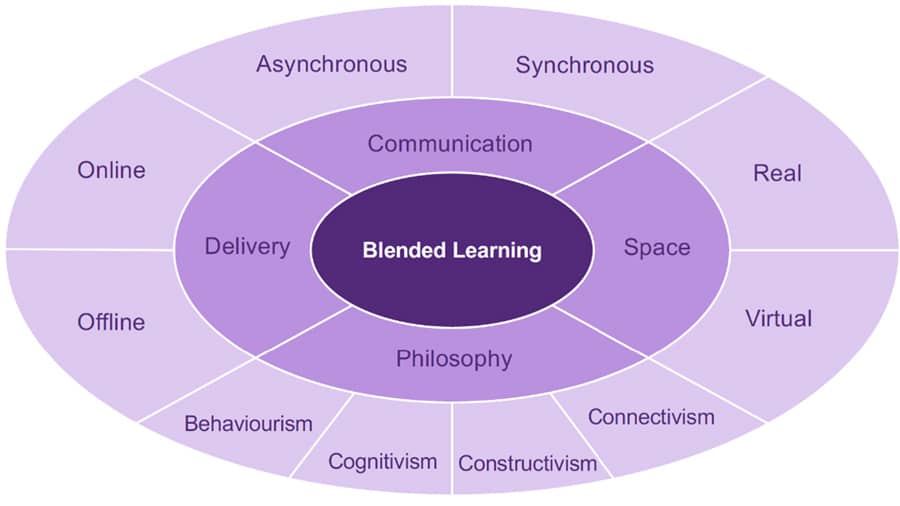Blended teaching
Blended teaching purposefully combines online and place-based learning.
Blended teaching or learning, as a term, arose at the time when educational systems were navigating entry into the online world. Thus, most early thinking about blended learning was focused on figuring out how to mix or blend learning that happens online with learning that happens on campus.
In this sense, blended learning offered students and lecturers a new kind of flexibility. Learning and teaching, and all the communication between learners and teachers, were no longer constrained to a physical location or dependent on face-to-face contact. In a very short period of time, all courses at UQ had an online presence through Learn.UQ (Blackboard) (learning management system) and the course profile.
Blended teaching/learning enables options for interaction, communication, space and educational philosophy as shown in the framework below:

Blended course models
| Mostly on-campus (traditional) course | Fully online course |
|---|---|
Weekly content delivery on-campus (lectures, workshops, lectorials, etc.) Weekly tutorials, pracs, placements on-campus Formative assessment (in Blackboard or in-class) Summative assessment (in Blackboard or in-class) Student communications (in Blackboard or in-class) | Weekly/module content delivered online (asynchronous or synchronous content delivery) Tutorials, practicals or laboratory sessions online Formative assessment/activities online Summative (graded) assessment online Student discussion forums online Student communications online |
| Blended course | |||
|---|---|---|---|
Model 1Weekly content on-campus Similar content online Tutorials/pracs on-campus Weekly tutorials, pracs, placements on-campus Formative assessment online integrated with content or on-campus during tutorials Graded assessment (on-campus and/or online) | Model 2Weekly content online only On-campus interactive workshops/lectorials/Q&As Tutorials/pracs on-campus Weekly tutorials, pracs, placements on-campus Formative assessment online integrated with content Graded assessment (on-campus and/or online) | Model 3Weekly content online only On-campus interactive workshops/lectorials/Q&As Tutorials/pracs on-campus with tutorial content online Formative assessment online integrated with content Graded assessment (on-campus and/or online) | Model 4Weekly content online only Online discussions/review of more difficult concepts Tutorials/pracs on-campus with tutorial content online Formative assessment online integrated with content Graded assessment (on-campus and/or online) |
Benefits of blended teaching
Research connecting active learning classrooms with student learning has been documented by Baepler et al. (2016) and shows that students in active learning:
- outperform their peers in traditional classrooms
- exceed their own grade expectations as predicted by standardised test scores
- show significant student learning gains over using a lecture-based approach in the same space.
Active learning approaches are evidenced with 'blended' learning practices that combine in-class activities with the delivery of online resources. It involves integrating and interspersing face-to-face engagement alongside interactive online activities.
A number of systematic analyses and meta-analyses have addressed the effectiveness of blended learning:
- Across 52 studies, Zhao et al. (2005) found a 0.49 effect size for online learning mixed with face-to-face instruction (i.e. greater achievement gain for blended learning).
- Bernard et al. (2014) found that, across 96 studies, blended learning conditions exceeded face-to-face conditions on any measure of academic performance (effect size 0.33).
- A 2004 meta-study by Prince found strong support for active, collaborative, cooperative and problem-based learning.
- Paul (2001) concluded that face-to-face with online enhancement was 11% more effective than face-to-face alone (perceptual skills, intellectual skills, motor skills, attitudes).
- Siemens, Gašević, & Dawson (2015) meta-analysis found effectiveness studies conclude that combining face-to-face and online modes support student academic achievement more than either mode independently. However, there is limited evidence of what methods of blending are most effective, with guidance mainly drawn from what works best in online and face-to-face teaching.
Resources
Need help?
Blended teaching approaches are supported across UQ through school and faculty learning designers.
ITaLI offers personalised support services across various areas including blended teaching.
